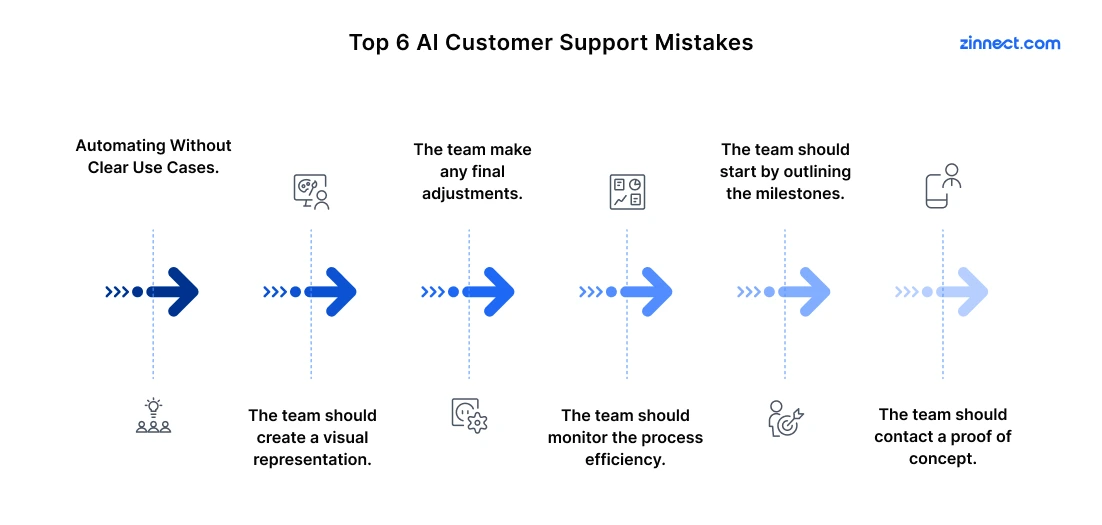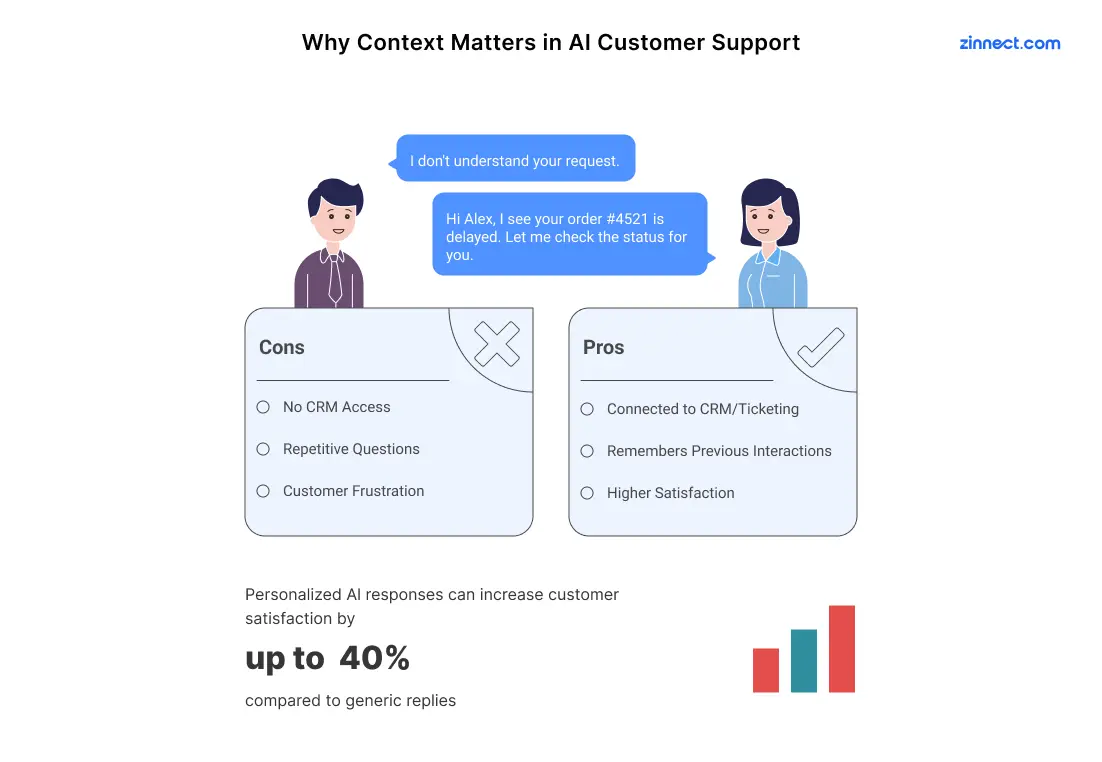Top six Pitfalls to avoid in AI Customer Support Automation

Customers today expect instant answers and seamless support. For small businesses, meeting these expectations is tough without the right tools. AI-powered support promises faster responses, round-the-clock availability, and less strain on human agents.
But technology alone is not a silver bullet. When automation is rolled out without a clear strategy, it often creates more frustration than convenience. The real challenge is not adopting AI but using it thoughtfully, like avoiding common AI customer support mistakes that can damage both customer trust and team productivity.
This article explores the key pitfalls businesses face in AI customer support. Learn how to prevent AI automation errors and chatbot setup issues, which in turn will allow automation to become a genuine advantage rather than a liability.

Pitfall 1: Automating Without Clear Use Cases
Many businesses also overlook the importance of aligning chatbot capabilities with real customer needs. If the bot cannot resolve common pain points or integrate with existing systems, it quickly loses relevance. Before deployment, analyze support tickets and identify top queries that can be automated without sacrificing quality. Define clear boundaries for what the bot should and should not handle.
Equally important is setting measurable outcomes such as reduced response times, higher resolution rates, or improved CSAT scores. By establishing these benchmarks early, businesses can track ROI and make data-driven decisions to enhance the chatbot’s performance over time.
Pitfall 2: Poor Chatbot Setup and Training
Another frequent mistake is deploying a chatbot with limited training data or relying solely on pre-built templates. Without exposure to real customer queries, the bot struggles to understand variations in language and intent. Businesses should use historical chat logs and support tickets to create a comprehensive intent library that reflects how customers actually communicate.
Continuous testing with real scenarios is essential to identify gaps and refine responses. Including fallback options and clear escalation rules ensures that conversations do not end abruptly when the bot cannot resolve an issue.
A systematic approach to training creates a chatbot that improves over time.
Pitfall 3: Ignoring Personalization and Context
A chatbot that gives generic, robotic replies feels disconnected from the user. Without CRM integration or access to order history, the bot cannot offer personalized support.
Integrating AI systems with ticketing platforms or CRMs ensures the bot remembers past interactions. This helps it deliver contextually relevant answers, creating smoother and more natural conversations.

Pitfall 4: No Human Escalation Path
Many businesses also fail to plan when and how the bot should hand over to a human agent. Without clear criteria for escalation, complex queries remain unresolved and frustrate users. Escalation triggers can be based on factors such as repeated failed intents, specific keywords like “refund” or “cancel,” or customer sentiment detected through natural language processing.
Once the handover occurs, agents should have full context of the conversation so that customers are not forced to repeat information. Designing this transition properly ensures that AI supports rather than replaces human service, creating a smoother overall experience.
Pitfall 5: Lack of Performance Monitoring
A static chatbot quickly becomes outdated if it is not maintained. Businesses should schedule routine reviews to analyze performance data and customer feedback. Key metrics like escalation rate, drop-off points, and customer sentiment provide insight into whether the bot is meeting expectations.
Regular audits of conversation logs help identify new intents that need to be added or responses that require improvement. Updating the bot to reflect changes in products, policies, and customer behavior ensures it remains relevant and effective.
Continuous monitoring and optimization transform the chatbot from a one-time project into a long-term asset for customer support.
Pitfall 6: Not Preparing Staff for AI Adoption
Another key issue is failing to involve support teams early in the AI implementation process. When employees feel excluded, they may view automation as a threat instead of a resource. Businesses should communicate the purpose of AI clearly, emphasizing how it will support agents rather than replace them.
Training programs should cover how to use AI tools effectively, interpret chatbot data, and handle escalations from automated systems. Encouraging feedback from staff helps refine workflows and creates a sense of ownership. When teams see tangible benefits, such as reduced repetitive workload and more time for meaningful interactions, adoption becomes much easier.
AI can reshape customer support by streamlining operations, reducing response times, and delivering faster resolutions. Yet its success depends on more than just installing a chatbot. The real value comes from aligning automation with business goals, continuously refining training data, and maintaining a clear human-AI balance.
Automation should never operate in isolation. It works best when support teams see it as an assistant that handles repetitive queries while they focus on complex cases that need empathy and judgment.
Avoiding the six pitfalls outlined above ensures that AI becomes a long-term asset rather than a short-lived experiment. Businesses that approach AI support with clear intent, consistent monitoring, and active staff involvement are far more likely to see measurable improvements in both efficiency and customer satisfaction.
For a deeper, step-by-step approach to designing an AI-powered helpdesk, read our full guide:Building an AI Helpdesk for Small Businesses: A Beginner’s Guide.